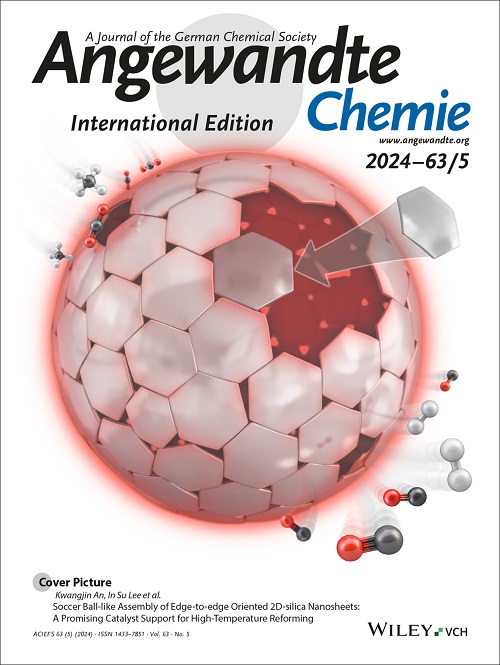Proton Driving Mechanism Revealed in Sulfur-Doped Single-Atom FeN2O2 Carbon Dots for Superior Peroxidase Activity.
IF 16.1
1区 化学
Q1 CHEMISTRY, MULTIDISCIPLINARY
引用次数: 0
Abstract
Heteroatom-doped single-atom nanozymes (SAEs) hold great promise as enzyme mimics, yet their catalytic mechanisms remain unclear. This study reveals that the proton driving mechanism induced by sulfur doping in single-atom FeN2O2 carbon dots (S-FeCDs) significantly enhances peroxidase (POD)-like activity. Synthesized via low-temperature carbonization, S-FeCDs exhibit FeN2O2 coordination with sulfur in the second shell, as confirmed by XAFS and AC-STEM. The POD-specific activity of S-FeCDs reached 295 U/mg, which is 11.2-fold higher than that of sulfur-free FeCDs, with natural enzyme-like kinetics. In situ experiments, kinetic and mechanistic studies revealed that sulfur doping promotes H2O dissociation, enhances H+ adsorption, reduces the ΔG for H2O2-to-·OH conversion. DFT revealed a lowered energy barrier for the rate-determining step (2*OH → *O+*H2O) from 2.50 eV to 1.62 eV. In vivo, S-FeCDs demonstrated broad pH efficacy in MRSA-infected wound models, achieving near-complete healing within 7 days. The proton driving mechanism was further validated through nitro compound reduction, demonstrating accelerated N-H bond activation. This work highlights the critical role of sulfur-induced proton dynamics in enhancing SAEs performance, providing a rational strategy for designing multifunctional nanozymes in biomedical and catalytic applications.硫掺杂单原子FeN2O2碳点的质子驱动机制研究
杂原子掺杂单原子纳米酶(SAEs)作为酶模拟物具有很大的前景,但其催化机制尚不清楚。本研究揭示了单原子FeN2O2碳点(S-FeCDs)中硫掺杂诱导的质子驱动机制显著增强了过氧化物酶(POD)样活性。通过低温炭化合成的S-FeCDs在第二壳层中与硫表现出FeN2O2配位,XAFS和AC-STEM证实了这一点。S-FeCDs的pod特异性活性达到295 U/mg,是无硫FeCDs的11.2倍,具有天然的酶样动力学。原位实验、动力学和机理研究表明,硫掺杂促进H2O解离,增强H+吸附,降低ΔG H2O2-to-·OH转化。DFT显示,2*OH→*O+*H2O的速率决定步骤的能垒从2.50 eV降低到1.62 eV。在体内,S-FeCDs在mrsa感染的伤口模型中显示出广泛的pH效应,在7天内实现几乎完全愈合。通过硝基化合物还原进一步验证了质子驱动机制,表明加速了N-H键的激活。这项工作强调了硫诱导质子动力学在提高SAEs性能中的关键作用,为设计生物医学和催化应用中的多功能纳米酶提供了合理的策略。
本文章由计算机程序翻译,如有差异,请以英文原文为准。
求助全文
约1分钟内获得全文
求助全文
来源期刊
CiteScore
26.60
自引率
6.60%
发文量
3549
审稿时长
1.5 months
期刊介绍:
Angewandte Chemie, a journal of the German Chemical Society (GDCh), maintains a leading position among scholarly journals in general chemistry with an impressive Impact Factor of 16.6 (2022 Journal Citation Reports, Clarivate, 2023). Published weekly in a reader-friendly format, it features new articles almost every day. Established in 1887, Angewandte Chemie is a prominent chemistry journal, offering a dynamic blend of Review-type articles, Highlights, Communications, and Research Articles on a weekly basis, making it unique in the field.

 求助内容:
求助内容: 应助结果提醒方式:
应助结果提醒方式:


